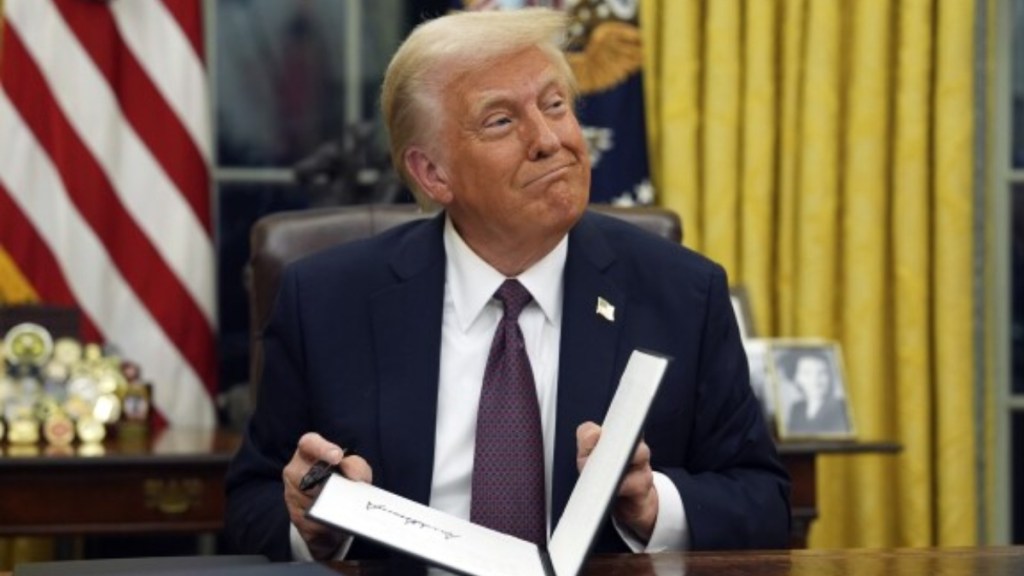By Anuj Dhawan
President Trump’s imposition of aggressive US tariffs is not just going to impact trade policy but also is likely to cause an upheaval in the global currency dynamics. The US tariff escalations risk accelerating a tectonic shift already underway: de-dollarization.
The US dollar has been the world’s reserve currency since the Bretton Woods Agreement of 1944. While the 1971 abandonment of the gold standard by President Nixon transformed the dollar into a fiat currency, untethering the dollar from gold and making the dollar reliant on global trust. However, the ‘Nixon shock’ also led to the birth of the petrodollar – was the
dollar backed by trust or did it need something more tangible, black gold! It is thus no surprise that when the Treasury undersecretary of the Nixon era, Paul Volcker, took over the Fed, he was equally experimental. The move to raise interest rates to 20% might have helped cement the petrodollar system, but it did further the distrust in the behaviour of the US polices and by extension in the dollar.
Paul Volcker’s successor Alan Greenspan took the other extreme – bailing out markets using low rates etc. The 2000 and 2008 bubbles have only led to growing noises around the role of the dollar as a true reserve currency.
As the world was recovering in 2013, the pressure to normalise led the erstwhile Fed chair Ben Bernanke to infamously deliver the ‘Taper Tantrum’. The ill-planned communication about withdrawal of quantitative easing led to currencies in India and Brazil plummet, leading to further questions about the intent of policymakers behind the US dollar.
The culmination of these moves has been aggressive rate moves by the current Fed chair Jerome Powell, to counteract the pandemic-era choices. While the US Fed has been ambivalent about the impact of tariffs, the likes of Goldman Sachs expect a 10% appreciation of the US dollar along with a 2-3% dent in S&P 500’s earnings. The uncertainty
in the dollar has not bode well for global trust with many alterative currency pairings having come up to hedge against the US dollar’s volatility.
In 2013, Saudi Arabia and China entered into a Petro-Yuan Pact, driven by China’s status as the middle-east’s top oil customer was designed to bypass the US restrictions.
In the aftermath of the Ukraine war, Russia and India entered into a Rouble-INR mechanism. Not only did bilateral trade between these two countries surge to over $60 billion but also are many other ASEAN and African countries now exploring
similar mechanisms.
The BRICS bloc (Brazil, Russia, India, China, South Africa) currency initiative has been in talks for a while, something that has been known to have antagonized President Trump.
These bilateral arrangements represent a growing consensus towards currency diversification, the network effects of which are likely to erode the dollar’s dominance. Moreover, the US tariffs exacerbate this trend towards de-dollarization by adding an extra layer of economic friction. When trading partners face increased costs to engage with the US market, they are likely to seek out alternative currencies to mitigate their risks.
This creates a feedback loop: as more countries continue to shift away from the dollar, the reduced transaction volume further undermines the US dollar’s position in the global financial ecosystem. The US has long enjoyed favourable rates due to the dollar’s status as the world’s reserve currency. As de-dollarization accelerates, the cost of US debt is also likely to rise, making the Triffin dilemma even more glaring – dollar’s global currency role conflicts with its domestic economic needs.
Conclusion
Whether President Trump’s tariffs are actual measures or negotiation tactics, the signal to unilaterally enforce protectionist measures is likely to accelerating the de-dollarization, a trend that has been quietly undermining US’ economic hegemony for decades.
Although the dollar’s decline may not be imminent, but its uncontested supremacy is. President Nixon’s unshackling of the gold standard taught us that currencies thrive on trust, a commodity that is eroded by tariffs, sanctions, and Fed missteps. And countries are voting with their reserves: Central Banks allocated 28% of their new reserves to non-dollar assets
in 2024, the highest since 1999. For India, this shift away from the dollar presents an opportunity. In the interest of fairer currency governance, India should be leveraging its G20 presidency to expand the use of the INR in bilateral trade. The need to hedge against the dollar is now not just a foreign exchange management exercise, but one to insulate itself from dollar whimsy. As the world grows wary of Washington’s fiscal adventurism, de-dollarization is likely to no more just be a trend but become the de-facto survival strategy in an increasing connected global economy.
The author is Head of Finance; Pricing Equipped AI, a B2B SAAS firm offering asset management solutions.
Disclaimer: Views expressed are personal and do not reflect the official position or policy of FinancialExpress.com. Reproducing this content without permission is prohibited.

